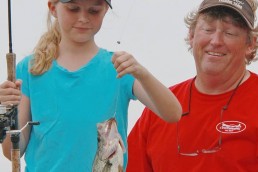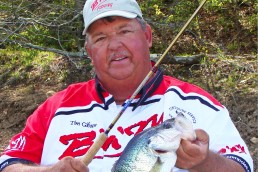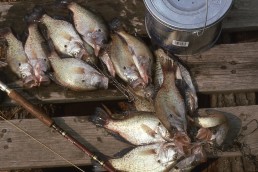Late-spring Transition Crappies
SHARE THIS POST
Crappie season isn’t over just because the fish have finished spawning. Rodney Neuhaus is a three-time Classic champ, and recommends following the crappies from shallow water to the main channel and deeper structures.
“The fish are in post-spawn and scattered,” Neuhaus says. “The good thing is you can go almost anywhere and catch a fish because they are scattered.”
He added that the water temperatures are usually in the 70s and 80s, so the brush piles are a good choice. But Neuhaus also has a preferred method.
“My favorite technique is jigging,” he says. “I’ll use a B’n’M 12-foot jigging pole, Power Pro braid, 15-pound-test line and a Road Runner Pro 2.0 Series head with a Midsouth tube. I might tip it with a minnow. The blade on the head is a willow leaf and works great when jigging.”
When fishing a brush pile, Neuhaus pulls out extra line, tosses the jig out and lets it fall slowly into the brush pile. A lot of times when it gets down to the brush he feels the thump. He added that the blade and glow-colored jig helps get the jig noticed.
June fish are changing to a summer pattern now. And on lakes with big, black crappies, fish shallow water early in the morning. They will be shallower early and then move out to deeper brush the rest of the day.
Neuhaus says blades can help catch more crappies, but there are times the fish prefer a plain head. He says on waters like Truman Lake is where a blade makes a difference in catching the bigger crappies, but there are other times when they won’t hit one so it’s best to try both.
Spider rigging in summer
Kentucky Lake expert and tournament fisherman Wade Hendren says fish will be in post-spawn and move to a more summer-type pattern.
This is when he heads to structure like stake beds, brush and contours.
Are you enjoying this post?
You can be among the first to get the latest info on where to go, what to use and how to use it!
“Our starting target range might be 8 to 10 feet deep, but will be 12 to 14 feet as the water heats up,” Hendren said. “Most of the time crappies will be right on the bottom and hugging tight to cover.”
Hendren says with today’s electronics it’s much easier to find the fish in cover.
“The crappies will be bunched up, but they are not going to be aggressive. You might catch 20 out of one brush pile then hit three or four other spots before finding another bunch. At least that’s what we’ve learned from experience.”
Hendren includes a 14-foot B’n’M jigging pole for a soft tip to see more bites and also prefers Tite-Lok rod holders. His baits are double-hook minnow rigs with the hooks 20 inches apart. He’ll sometimes use a Midsouth or Slider jig tipped with a minnow.
As it keeps getting warmer toward July his presentation will include marking a spot with a buoy, positioning his boat facing into the wind and then getting baits into the cover. Then it’s just a matter of leaving the baits still. If he doesn’t get a bite within a few minutes he’ll leave and find another spot.
Boat control is also critical he says.
“A fisherman must stay in control, even in the wind, with pleasure boaters and jet skis. Going slow is critical in hot water.”
Bonus tips
It’s easy to get distracted when a lake gets busy or the fishing gets slow. It’s important to pay attention to your line and pole tips or you could miss the lighter bites. Jigging might work best in a lake full of stumps or trees, so start with a heavy 1/8- or 3/16-ounce jig and 2 1/2- or 3-inch body. You’ll then be able to fish with better control. If that doesn’t work, downsize to 1/16 ounce and a 2-inch body.
Never fish a jig without using an attractant. Berkley Crappie Nibbles, Bobby Garland Slab Jam and Bang Garlic spray are all good. Include scent even when tipping with a minnow. Each lake is different, so check a variety of depths to learn the strike zone this summer. And remember, it’s important not to fish below the fish.
MWO
SHARE THIS POST
Did you enjoy this post?
You can be among the first to get the latest info on where to go, what to use and how to use it!
Tim Huffman
Tim Huffman specializes in crappie fishing, is editor for two crappie magazines, as well as writing for several others. In 2018, he published his sixth book, Limiting Out for Crappie, available at Amazon. His first article appeared in MidWest Outdoors in 1988.



